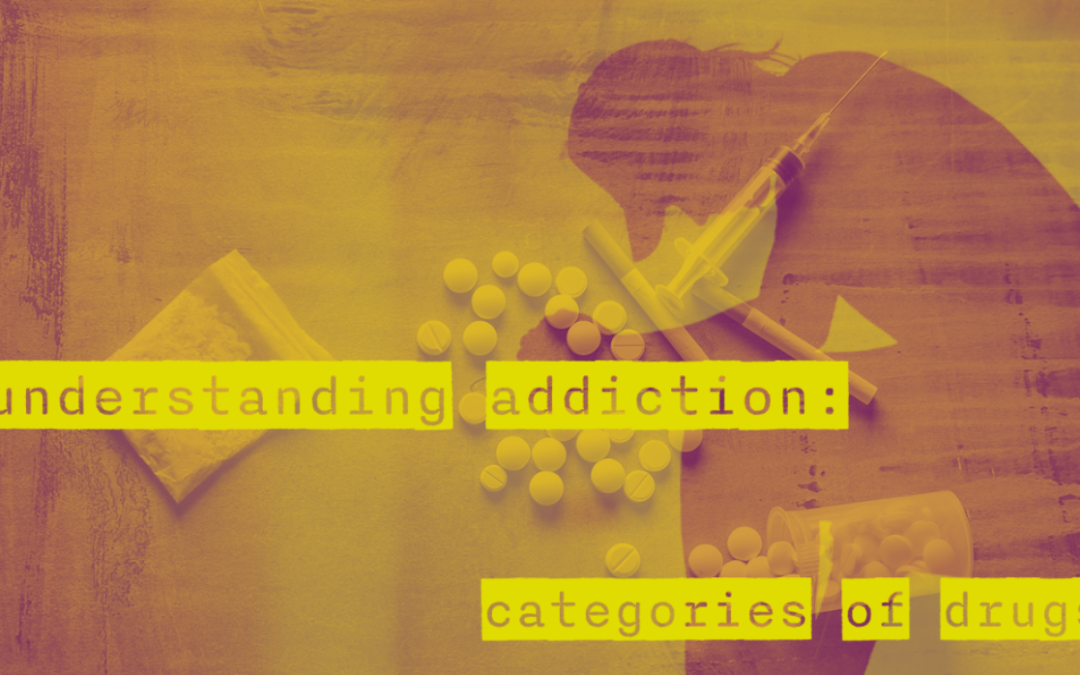Categories of Drugs of Abuse
One of the ways we as humans understand what is going on around us is through systematization of knowledge – and often this means categorizing or grouping concepts together.
In regards to drugs we categorize the various substances of abuse into categories. We do this for a number of reasons. These substances are grouped together based on chemical compostion, how they work and the effect of the substance on the brain and the body. The classification of drugs by chemical similarity can help us understand the usage patterns of the user. The typical drug user who is addicted to a specific substance will often be more likely to abuse a chemically similar substance. Although many drug users do experiment with a range of substances across these categories it is more likely that they will have a preference towards one specific category. For example, the meth addict will be more likely to abuse other amphetamines or stimulants such as cocaine, methylphenidate or MDMA rather than a depressant such as alcohol or opiates.
This does not mean to imply that the drug user will not abuse drugs from another category. It simply means that they are less likely to do so.
Categorizing these substances also helps us understand the health risks and impact of these substances as drugs of a similar chemical composition will often, but not always, have similar side-effects, symptoms and risks. The approaches to treatment is often also impacted by these categories. The stimulant addict’s program will differ from the opiate addict or alcoholic.
Below we will have a look at the different categories used to classify drugs of abuse.
Central Nervous System (CNS) Depressants
As the name implies a depressant is a class of substance that slows down the operations of the brain and body.
This category includes Alcohol, Benzodiazepines (Valium, Xanax, Ativan, Klonopin etc.), Barbiturates, GHB (Gamma Hydroxybutyrate), Rohypnol, and certain anti-depressants (Bupropion and Setraline).
Central Nervous System (CNS) Stimulants
Where the depressants slow down the operations of the brain and body, substances in this class raise blood pressure, ‘speed up’ or overstimulate the body. Many of the drugs in this class are also used for the treatment of ADHD – for example methamphetamine, methylphenidate and dextroamphetamine. These drugs are characterized by cognitive and emotional effects like increased wakefulness and feelings of euphoria.
Their main effects tend to target the norepinephrine and dopamine neurotransmitter systems.
Many users find themselves in a constant state of flight or fight as the adrenaline triggers are often overstimulated.
Drugs in this category include amphetamines, prescription medications like ritalin and adderal, cocaine (and crack) and methcathinone (CAT). This category also includes caffeine and nicotine.
They are commonly referred to as uppers.
Hallucinogens
Hallucinogens or Psychedelics have been used for centuries as a way to alter ones perception of reality. Although their medical use has been explored and continues to be explored especially as a treatment for certain psychiatric disorders, they are often used recreationally and can have serious mental health risks. These drugs are often not as addictive as other classes of drugs, but can still be just as harmful.
Their immediate effects are generally more severe and dangerous.
Characterized by visual and auditory hallucinations, this category includes drugs like LSD, Peyote, Salvia and Psilocybin.
Marijuana is also often categorized under this group but can also be classified as a CNS Depressant.
Dissociatives
Although closely related to Hallucinogens, these drugs work by interfering with the brain’s receptors for the chemical glutamate, which plays a significant role in cognition, emotionality and pain perception. This class of drug severely distorts the user’s sense of reality and causes them to dissociate causing a feeling of disconnection or separation from the self.
Drugs in this category include Ketamine, PCP (Angel Dust), Dextromorphan (DXM). These drugs can often have chemical similarities to stimulant drugs.
Opiates
Although all of the drugs in this category could also be classified as CNS depressants we refer to opiates as a separate category. Most opiates are distributed and taken in the form of prescription pain killers. Treatment for opiate addiction is very specific and usually if not always includes full medical detox.
Opiates are a type of drug that includes both illicit narcotics and prescription medications. Heroin, morphine , fentanyl and codeine are all examples of opiates.
These substances are derived from the opium poppy or substances with similar effects on the brain or body. Artificial substances with the same effect are referred to as synthetic opioids. These drugs depress your central nervous system and are used for pain relief and as anaesthesia but is often misused or abused because of the feelings of euphoria it produces.
Inhalants
Inhalants are any chemical substance that can be inhaled to produce an altered state of mind. Common especially among adolescents this category includes aerosols, gases and solvents – chemicals like glue and paint thinners or even petrol, paint and butane (CADAC) gas.
If you or a loved one are struggling with addiction or with issues related to mental health please consider reaching out by sending an email to andre@adlabuschagne.co.za and we will assist you with finding an option that works for you.

